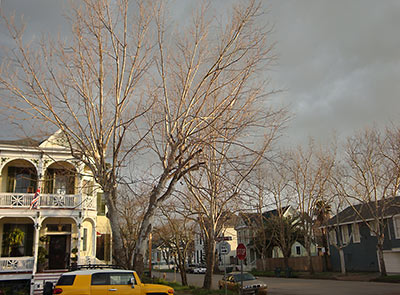
Salt water from Hurricane Ike damaged 11,000 trees on city property in Galveston — and as many as 31,000 more on private property will need to be cut down. The Chronicle‘s Allan Turner reports:
The process will involve a tree-by-tree examination, the Texas Forest Service’s Pete Smith said. Candidates for cutting will include most tree varieties that have lost 50 percent or more of their canopy. Live oaks with at least 30 percent of their leaves may be spared. The live oaks, Smith said, are “either recovering or dying,†and more time is needed to determine which is the case.
Officials hope to remove doomed trees [on city property] by the middle of September, thereby qualifying for federal payments that could cover up to 75 percent of the city’s removal cost.
. . . Removing every dead tree on both public and private land could cost about $5 million, according to city estimates, although the federal government will pay to remove only those in the city right of way.
- Thousands of dead trees to be removed soon [Houston Chronicle]
- Previously in Swamplot: Galveston for Tourists: Not Quite Yet
Photo: Flickr user lutzman–





I drove down Broadway this weekend, and it’s heartbreaking. All the oaks look dead dead DEAD. It’s really a shadow of what it once was, and I don’t know what they’re going to be able to do about it.
(Well, for starters, they can get their signals timed better — I’d rather not have to stop at every freaking light so that I’m forced to dwell on the depressing sight!)
As usual, Mother Nature is bitch.
I was in Galveston last Saturday for the annual Sand Castle Competition. Just driving down Broadway, you would think it was the heart of winter with no leaves on the trees.
The palm trees were doing fine. A few oaks did have new leaves and appear to be able to make a recovery (but I’m not an arborist).
This will be just like after the recovery of the 1906 storm all over again when many of these trees were originally planted
Yeah, I was thinking about that while trimming my oak trees. My small oaks were planted in 1990 and now they are big trees. Not as big as the Galveston ones, but substantial. If they plant new saplings and don’t lose them to salt water, it should look OK in ten years or so.
The critical thing to remember is that yes this a loss of a great old oaks, but but we can always renew. Trees are renewable and expendable. That’s the real reason why they are so great!
The Giving Tree wasn’t renewable. But she was still great for climbing and building boats and houses and stuff. Also good for sitting.
The giving tree was so busy being thankless that it forgot to reproduce. It could have produced many trees that could serve the boys future children and grand children.
The story is sweet to kids because it teaches them not to abuse other’s generosity and be thankful, but for the real world it is fatally flawed. The Giving Tree decided not to reproduce. That would have also been a great act of giving…
Oh kjb! you want to make “The Giving Tree“ about tree-sex!?
I’ll bet Shel Silverstein had the tree doing its woody best to propagate, but, people kept mowing the baby sprouts down! In the end, people decide where & when trees grow…
Re: the book, I happen to like that it’s a Downer and the tree gives its all & ends a stump – kids need some sadness.
Yet on your opinion: “we can always renew. Trees are renewable and expendable. That’s the real reason why they are so great!â€
For oaks sake! a really good tree takes half a century to grow! Shopping malls and feeder roads have a much shorter timeframe than that.
I really wish the city would insert (& water/protect) some little live oaks among the big guys along MacGregor, Main, Rice… to get a running start on preserving the canopy, when the inevitable tree deaths occur.